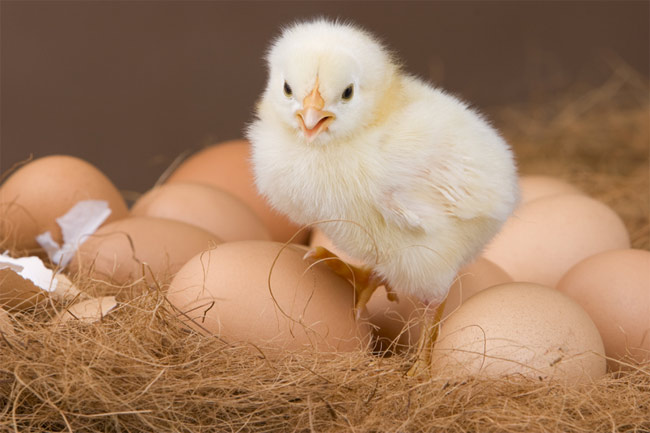Which Came First? Eggs Before Chickens, Scientists Now Say

A rare fossilized dinosaur nest helps answer the conundrum of which came first, the chicken or the egg, two paleontologists say.
The small carnivorous dinosaur sat over her nest of eggs some 77 million years ago, along a sandy river beach. When water levels rose, Mom seems to have fled, leaving the unhatched offspring.
Researchers have now studied the fossil nest and at least five partial eggs. The nest is a mound of sand that extends about 1.6 feet (half a meter) across and weighs as much as a small person, or about 110 pounds (50 kg).
"Some characteristics of the nest are shared with birds, and our analysis can tell us how far back in time these features, such as brooding, nest building, and eggs with a pointed end, evolved — partial answers to the old question of which came first, the chicken or the egg," said researcher Francois Therrien, curator of dinosaur paleoecology at the Royal Tyrrell Museum in Alberta, Canada.
The answer?
Well, it’s still unclear whether chicken eggs or chickens came first (the intended question in the original riddle), said Darla Zelenitsky, a paleontologist of the University of Calgary in Alberta who was the first scientist to closely analyze the dinosaur nest.
But interpreted literally, the answer to the riddle is clear. Dinosaurs were forming bird-like nests and laying bird-like eggs long before birds (including chickens) evolved from dinosaurs.
Get the world’s most fascinating discoveries delivered straight to your inbox.
"The egg came before the chicken," Zelenitsky said. "Chickens evolved well after the meat-eating dinosaurs that laid these eggs."
So the original riddle might now be rephrased: Which came first, the dinosaur or the egg? Meanwhile, the new nest provides some of the strongest evidence in North America in favor of the bird-like egg over the chicken.
Rare dino nests
The fossil nest was collected in the 1990s and kept at Canada Fossils Limited in Calgary, Alberta. That's where Zelenitsky first spotted the remains, which were labeled at first as belonging to a duck-billed dinosaur, an herbivore. (In 2007, the fossil was acquired by the Royal Tyrrell Museum of Paleontology in Alberta.)
Zelenitsky realized that the nest and eggs actually belonged to a small theropod, a meat-eating dinosaur. In particular, the egg-layer was likely a maniraptoran, the group of theropods that paleontologists think birds derived from some 150 million years ago during the Jurassic Period.
"Nests of small theropods are rare in North America and only those of the dinosaur Troodon have been identified previously," said Zelenitsky. "Based on characteristics of the eggs and nest, we know that the nest belonged to either a caenagnathid [a family of maniraptorans] or a small raptor, both small meat-eating dinosaurs closely related to birds."
She added, "Either way, it is the first nest known for these small dinosaurs."
The only other egg clutch identified to date from a maniraptoran in North America belonged to Troodon formosus.
Egg-laying behaviors
The analysis of the nest, detailed in the latest issue of the journal Palaeontology, provides paleontologists with information about egg-laying in this particular dinosaur and others, along with the evolution of various egg-laying behaviors, Therrien said.
"Our research tells us a lot about the dinosaur that laid the eggs and how it built its nest," he said.
For instance, the position and spacing of the eggs suggest the original clutch contained at least 12 eggs arranged in a ring around the mound's flat top, where the theropod would have sat and brooded its clutch. The eggs were about 5 inches (12 cm) long and, like bird eggs, they were pointed at one end.
The analysis also suggests the dinosaur laid its eggs two at a time on the sloping sides of the mound. That's unlike, say, crocodiles, which lay all their eggs at once, and more like birds, which lay one egg at a time. (The ancestors of crocodiles gave rise to dinosaurs and later on, birds.)
As if figuring out the chicken-egg puzzle weren't enough, the researchers also have another objective: "To find the same kind of nest with babies inside," Zelenitsky told LiveScience. "There are dinosaur eggs from North America with baby bones preserved inside of them. It's entirely possible, but again these types of nests (from small meat-eating dinosaurs) are fairly rare."
The research was funded by Richard and Donna Strong, the Alberta Ingenuity Fellowship Fund and the Killam Fellowship Fund.
- Avian Ancestors: Dinosaurs That Learned to Fly
- Birds of Prey: Spot Today's Dinosaurs
- Dino Quiz: Test Your Smarts
Jeanna Bryner is managing editor of Scientific American. Previously she was editor in chief of Live Science and, prior to that, an editor at Scholastic's Science World magazine. Bryner has an English degree from Salisbury University, a master's degree in biogeochemistry and environmental sciences from the University of Maryland and a graduate science journalism degree from New York University. She has worked as a biologist in Florida, where she monitored wetlands and did field surveys for endangered species, including the gorgeous Florida Scrub Jay. She also received an ocean sciences journalism fellowship from the Woods Hole Oceanographic Institution. She is a firm believer that science is for everyone and that just about everything can be viewed through the lens of science.


